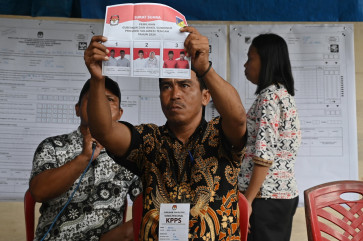Popular Reads
Top Results
Can't find what you're looking for?
View all search resultsPopular Reads
Top Results
Can't find what you're looking for?
View all search resultsDieng dreadlocks get ceremonial chop
Getting a haircut is normally a straightforward affair
Change text size
Gift Premium Articles
to Anyone
G
etting a haircut is normally a straightforward affair. However, for the children who grew up near the Dieng temple complex in Banjarnegara regency, Central Java, a haircut involves a special ceremony with extraordinary gifts and thousands of spectators.
Inexplicably, the children of the Dieng plateau have developed unintentional, naturally occurring dreadlocks, usually after experiencing a high fever. These dreadlocks, viewed as a sign of cosmic favor, and are allowed to grow until the child asks for them to be cut.
This year, a number of local officials, including Regent Sutedjo Slamet Utom, trimmed the locks of six children in a ritual event featured as part of the Dieng Cultural Festival.
Dieng traditional community head Maryono led the ceremony at Puntodewo temple in the Arjuno temple complex on July 1, as thousands of visitors, including foreign tourists, swarmed the temple complex to take photos.
One by one, the children’s dreadlocks were cut by high-ranking officials of Banjarnegara regency administration.
For decades, the phenomenon of the Dieng dreadlocks has escaped scientific explanation.
According to Dieng Pandawa Tourism Awareness Community head Alif Fauzi, the phenomenon is associated with a tale about a 14th century founding figure of the Wonosobo municipality, Kyai Kolodate.
“Given his divine power, Kyai Kolodete was able to establish a relationship with the ruler of the South Sea, Nyai Roro Kidul, from whom he received his dreadlocks. Nyai Roro said some of Kolodate’s offspring would have dreadlocks, which must be returned [to the sea],” said Alif.
Housewife Muslihah, from Batur, Banjarnegara, said her daughter Nadia Ratnawati, 4, formed dreadlocks when she was 1 year-old. “At that time, she suffered from a fever for a month. After that, she grew dreadlocks,” said Muslihah. Nadia took part in the dreadlock-cutting ritual, and for that, she asked for Rp 101,000 (US$10).
Another local resident, Maryono, also brought his son Baqiatus Syifaul Bakayu, 4, who also sports dreadlocks to the ritual. When he was 2 years-old, Syifaul suffered from a high fever and later grew dreadlocks also. “To cut his dreadlocks, he asked for a bicycle and 10 eggs,” said Maryono.
The ceremonial procession began at Maryono’s house, located not far from the Dieng temple complex. After the six children in dreadlocks were paraded around the village, they were brought to Sendang Sedayu in the temple complex to be ritually cleansed.
They were later brought to Puntodewo temple to have their hair cut, followed by a joint prayer. The freshly shorn dreadlocks were later set adrift on Telaga Warna Lake, to make their way along the Tulis River and eventually to the South Sea.
Visitors paid Rp 25,000 to watch the procession up close, enthusiastically doing so despite the scorching sun.
Alif said the dreadlock phenomenon was a blessing from God and that people should be thankful. “We have to be thankful, as the ritual could draw thousands of visitors and bring blessings to Dieng residents,” he said.
Dieng resident Sudiyono, 52, said the ritual was usually held in a simple manner, followed by a feast and a gift-giving ceremony. “If the [children’s] wishes are not met, they will grow dreadlocks again,” said Sadiyo, whose child also has dreadlocks.
Banjarnegara regency spokesman Sudin said the local administration had intentionally held the ritual during the Dieng Cultural Festival to draw visitors to the Dieng plateau.










